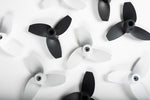
Design of our propellers
, by Nicolas Quendez, 2 min reading time

, by Nicolas Quendez, 2 min reading time
The main reason for the performance of our electric propulsion systems is that we master their design from A to Z. Everything is optimized to achieve exceptional performance while maintaining a reasonable price: battery, electric motor, propeller! An immersion into our design secrets for your boats...
The main reason for the performance of our electric propulsion systems is that we master their design from A to Z. Everything is optimized to achieve exceptional performance while maintaining a reasonable price. Designing an electric boat motor requires optimizing the entire propulsion system, so that each "stage" operates as close as possible to its maximum efficiency:
At Kahe Nautic, we also have a patented system that allows us to do without a gearbox: the propeller is directly connected to the electric motor. This means there's no performance degradation with a gearbox, no maintenance required on our propulsion systems, and excellent reliability.
Today, some details of the Kahe POD 600 propeller design, as well as its fairing:
1) The profile of the blades
The profiles of our propeller blades are specific, we design them digitally to achieve 2 objectives:

- Minimize the drag generated by the blade profile, at all propeller operating points (from low power to maximum power)
- Never be able to enter cavitation. Cavitation is a phenomenon that occurs when the depression generated by the blade is so great that the water vaporizes around the blade! The blade then rotates in the middle of water vapor bubbles, and its performance deteriorates significantly. Our profiles are designed so that the depression is well distributed across the entire profile, and never exceeds the critical value leading to cavitation.
2) The geometry of the blade
The 3D geometry of the blade is an optimization of many factors: the evolution of the chord of the profiles used, the evolution of the profiles themselves, the twist and the sweep of the blades. We use numerical optimization methods to achieve the best possible compromise.


